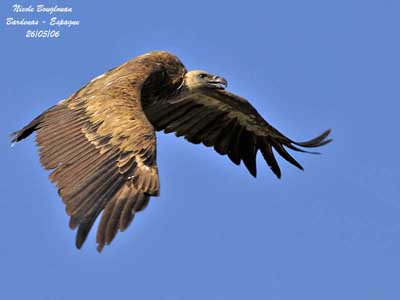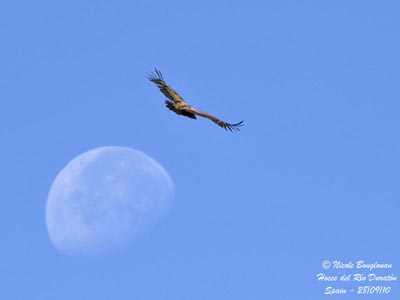Text by Nicole Bouglouan
Photographers:
John Anderson
John Anderson Photo Galleries
Beamonte José Luis
Pájaros de España
Buysse Didier
Vision d’Oiseaux
Fenerole Jean Michel
Photos d’Oiseaux
Garvie Steve
RAINBIRDER Photo galleries
Mistry Niraj Vijaykumar
Photo Galleries
Jean Marc Rabby
Des Ailes et des Plumes
Ingo Waschkies
Bird Photography
Callie de Wet
GALLERY
Bouglouan Nicole
PHOTOGRAPHIC RAMBLE
Sources :
BIRDS OF AFRICA SOUTH OF THE SAHARA by Ian Sinclair and Peter Ryan - Princeton University Press Princeton and Oxford - ISBN: 0691118159
ROBERTS BIRDS OF SOUTH AFRICA by G. R. Mc Lachlan and R. Liversidge – The Trustees of the John Voelcker Bird Book Fuund – ISBN: 0620031182
BIRDS OF PREY OF AFRICA AND ITS ISLANDS by Alan and Meg Kemp - Struik Publishers - ISBN: 1770073698
GUIDE DES RAPACES DIURNES – Europe, Afrique du Nord et Moyen-Orient de Benny Génsbol – Delachaux et Niestlé – ISBN : 2603013270
L’ENCYCLOPEDIE MONDIALE DES OISEAUX - Dr Christopher M. Perrins - BORDAS - ISBN: 2040185607
HANDBOOK OF THE BIRDS OF THE WORLD Vol 2 by Josep del Hoyo-Andrew Elliot-Jordi Sargatal - Lynx Edicions - ISBN: 8487334156
BirdLife International (BirdLife International)
The Old World Vultures
These unloved birds!
Often wrongly accused of crimes they are not committed, or considered as dirty, ugly, dangerous, carriers of diseases or viruses… to make a long story short, the vultures disturb!
Whatever country they are living, these large birds are suffering or have suffered persecution, direct or indirect poisoning and shooting.
They are unloved, but why?
The vultures are scavengers. All the countries where they are living need them to clean the nature. They feed on carrion of all types, from large mammals to small birds or fish according to the range.
In the Himalayas, the vultures were in charge of feeding the bodies of dead people because the wood was rare and expansive, and the frozen soil did not allow burying the corpses. The Eurasian Griffon Vulture and Cinereous (Monk) Vultures fed the flesh and the Bearded Vultures took the bones.
This practice is still used today, but much more rarely.
The vultures are mentioned in legends and myths of several countries
There are numerous examples. They can be related to the death, the war or the blood, due to their feeding habits. But their large size and powerful stance are also associated to protection and defence of the young, whereas their ability to soar high in the sky, make them nearer to God.
Formerly, these birds were respected and revered by humans.
Why are they killed today?
Only one way to know them better: to study them!
Gyps fulvus
The vultures belong to the large family Accipitridae, divided in nine natural groups. They are the third group, including today 16 species and 9 genera. They do not have their own family, in spite of their different appearance and behaviour compared to the other birds of prey.
The most important genus Gyps, includes eight “typical” vultures’ species as we always have imagined these birds before to see them.
With the other eight genera, they share several peculiarities related to their appearance, their feeding and scavenging habits.
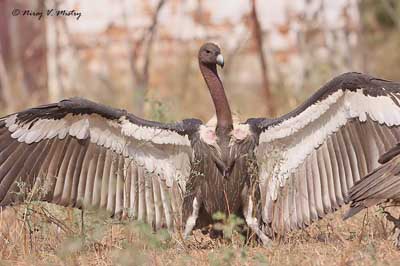
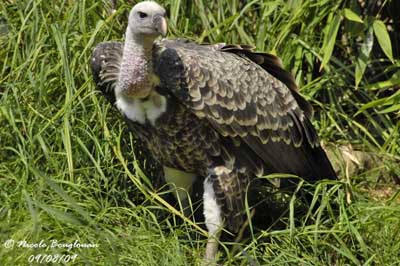
The vultures of the genus Gyps are large raptors, with a wingspan from 200 to 260 cm, and a weight of about 6000 to 12 000 grams. They have similar plumage pattern but more or less dark upperparts.
The eight species have dark brown to blackish flight feathers, pale buff to white ruff, and sparsely covered in whitish to brownish down neck and head. The bare face varies from pinkish to bluish through greyish and brownish. The strong hooked bill is usually horn-coloured, more or less pale or dark according to each bird. The eyes are dark brown to yellow. Legs and feet are greyish to blackish.
All are scavengers, feeding at large carcasses, often with other species.
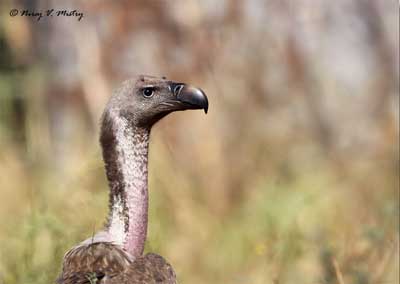
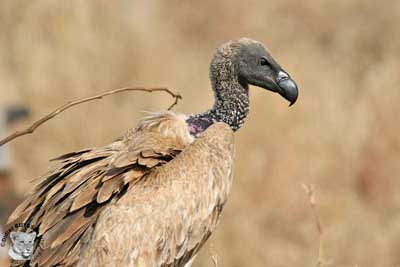
The eight other genera can be classified in four different groups with relatively close appearance.
The Egyptian Vulture (Neophron percnopterus) and the Hooded Vulture (Necrosyrtes monachus) have similar silhouette but different plumage colour. The first one is whitish with black flight feathers, it has feathered head except the bare yellow face and bill and pinkish legs and feet. The second has brown plumage overall with white feathers at base of the foreneck, some grey down on crown and hindneck, bare pink face and bill and greyish legs and feet.
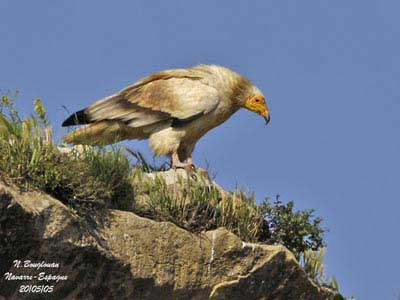
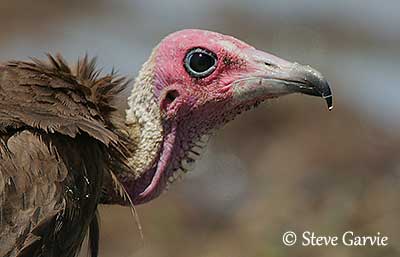
Both are fairly small and have slender bills compared to those of the vultures Gyps. For this reason, they are unable to compete with larger species around the carcasses, and only take scraps. However, they can reach the meat between the bones when the other vultures have left.
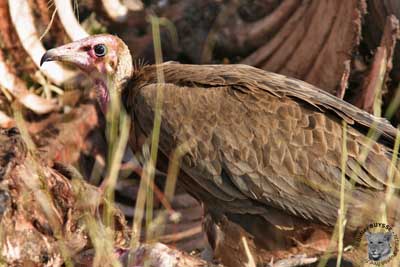
Necrosyrtes monachus
The Eurasian Black Vulture (Aegypius monachus), the Lappet-faced Vulture (Torgos tracheliotus), the White-headed Vulture (Trigonoceps occipitalis) and the Red-headed Vulture (Sarcogyps calvus) are larger than the previous. They have bare head and neck, from bluish-grey or pink, to white or red. The bare skin may change if the bird is excited, turning brighter or paler.
The two first species are larger, with dark brown to blackish plumage. The Lappet-faced Vulture has white underparts, heavily streaked brown on the breast and upper belly, whereas the Eurasian Black Vulture is blackish overall. Its large size makes it dominant at carcasses.
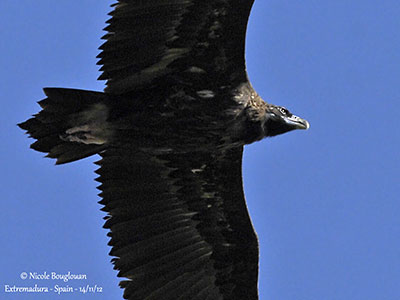
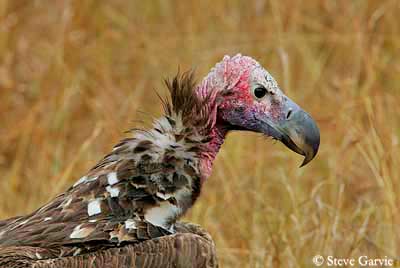
Aegypius monachus
The two other species are slightly smaller than them, and have dark brown plumage on the upperparts, with paler flight feathers. The White-headed Vulture has black and white underparts, white and pink bare face, reddish bill and pale pink legs and feet, whereas the Red-headed Vulture is dark with white patches on the underparts, red bare head, neck and legs, and black bill.
They feed on carrion at large carcasses, and often pirate food from other vultures.
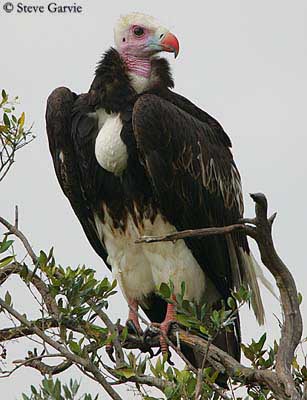
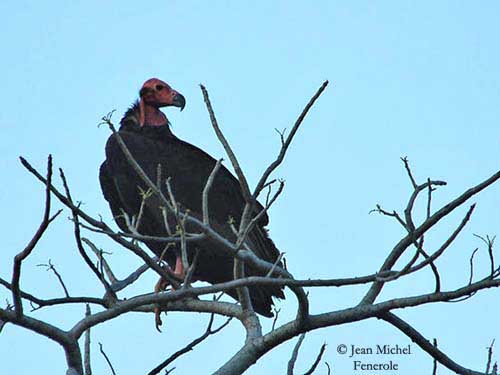
The Bearded Vulture or Lammergeier (Gypaetus barbatus) is very large and has different appearance with black wings and tail, and whitish underparts and neck. But they often turn chestnut-orange due to the mineral particles, result of dust-bathing. The whitish head shows black lores, and a kind of black “beard” below the base of the horn-coloured bill. The eyes are yellow with red eye-ring.
This species feeds mainly on bones and marrow taken at carcasses. The larger bones are broken by dropping them on rocky surface while flying.
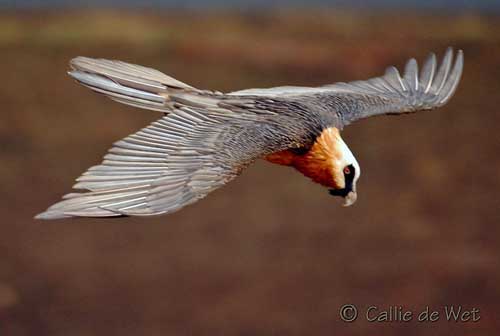
Gypaetus barbatus
The last species, the Palm-nut Vulture (Gypohierax angolensis) of which both anatomy and food habits could be intermediate between fish-eagles and vultures, is very different with very contrasted black and white plumage, bare red face, pale grey bill with yellow cere, pale pinkish to yellowish legs and feet.
This species feeds primarily on fleshy pericarp of palm-fruits. It also takes fish, crabs, amphibians and molluscs, and medium-sized birds or injured mammals or as carrion. But as some fish-eagles do, it also takes fish from the water surface or by paddling around the shoreline.
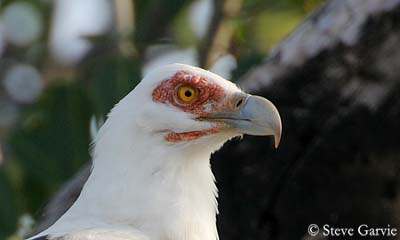
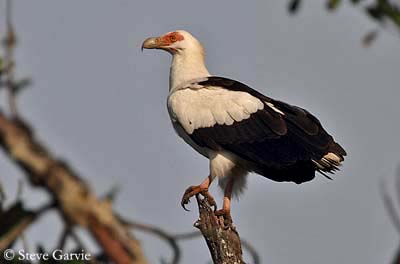
If the chick is usually covered in white down, the juvenile is often brown with duller bare parts, sometimes very dark such as in Bearded Vulture.
They need several years to gain the adult plumage and to breed.
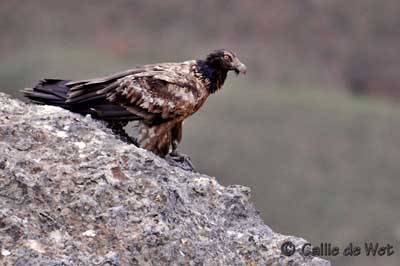
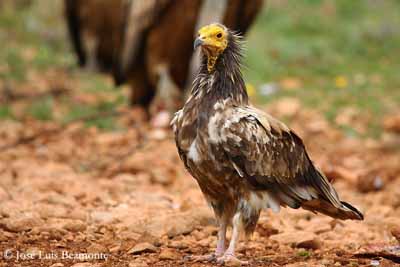
All the species are scavengers, feeding carrion in variable amount. They do not kill healthy living animals, or only when injured or disabled and weak. They do not have the “tools” for that, they lack the sharp talons, and even their strong hooked bills and their large size do not allow them to kill as eagles and other birds of prey do.
The vultures are not very vocal, except around the carcasses when they feed with other vultures. They utter series of grunts and croaks, but also hisses, screeches and high-pitched chatters usually heard during interactions when they are feeding.
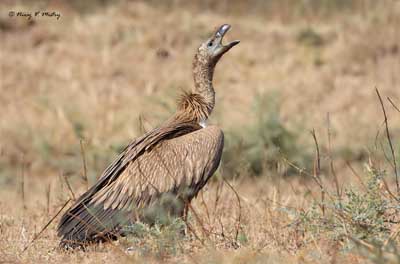
Gyps fulvus
Except the Palm-nut Vulture, they locate the food thanks to their keen eyesight while flying. They descend little by little, watching around before to reach the food.
Disputes often occur around carcasses. The large vultures such as the Eurasian Black Vulture and the Himalayan Vulture are dominant and feed first. Then, other smaller species approach and take the scraps. There are interactions between them, including between the vultures which are waiting for feeding behind the dominant birds.
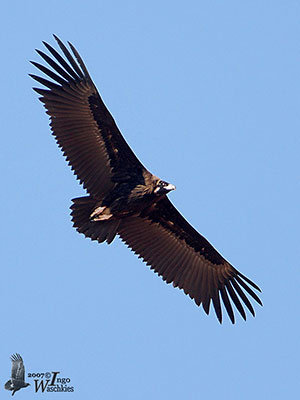
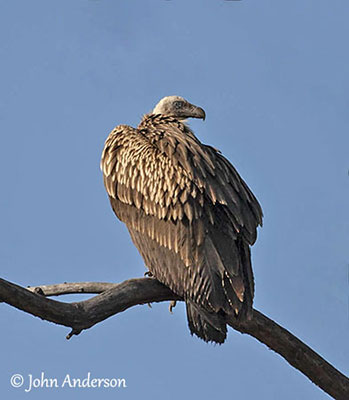
The threat display is typical, with neck and head held almost horizontally, walking forwards towards the others, but also walking with one leg held forwards while they give hisses at the neighbours.
Eurasian Griffon Vulture - Gyps fulvus
They take turns around the food. Each species takes particular parts of the carrion, from the best parts of the meat to the bones.
A large carcass can be eaten very quickly, sometimes in a few hours.
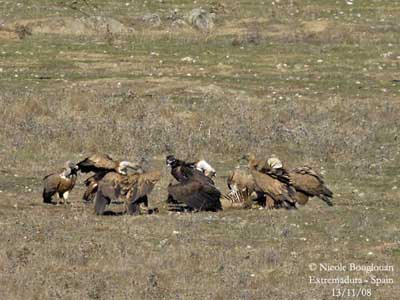

Eurasian Griffon Vulture - Gyps fulvus
Rüppell's Vulture - Gyps rueppellii
Vultures usually are gregarious birds, roosting, feeding and breeding together. Several species breed in large or small loose colonies, as well in treetops as in cliff faces, on rocky ledges sometimes with overhanging. Some others nest solitary.
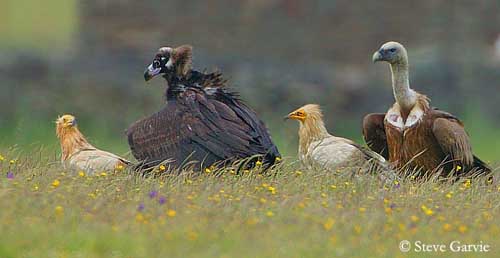
Aegypius monachus
Gyps himalayensis
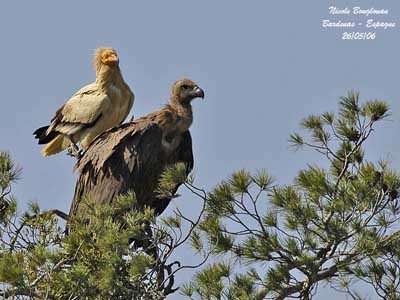
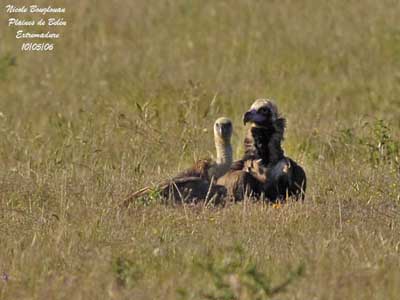
The nest is a platform, made with sticks and lined with green leaves or dry grass.
These large raptors perform aerial displays above the nest-site, flying and soaring together, close to each other. These flights are named “flight in tandem”, and show the birds soaring one above the other or side to side during long periods. They also can flight in circles close to the nest-site.
The solitary nesters are territorial and chase away from the nest all the intruders.
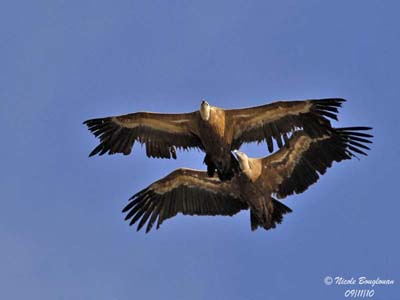
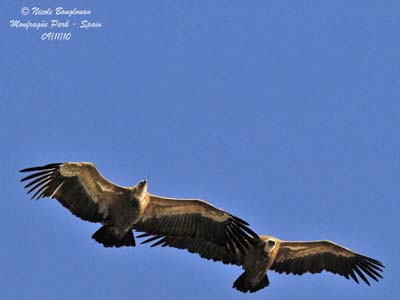
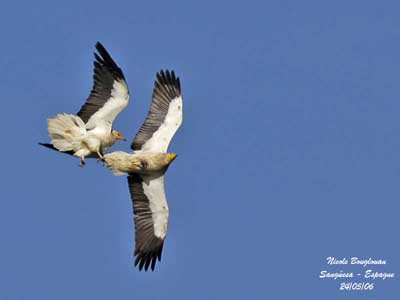
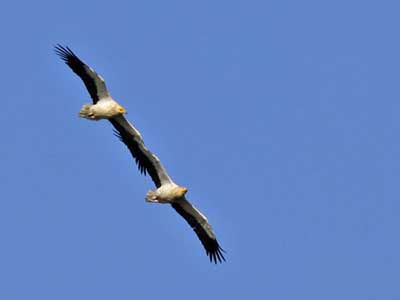
Usually, a single egg is laid, rarely two. Both parents take turns and incubate. The period can lasts from 42-44 days in smaller species to 58-62 days for the largest vultures. At hatching, the chick is covered in white down. An adult remains at nest with it while the other carries the food. Both parents care the chick and share the nesting duties.
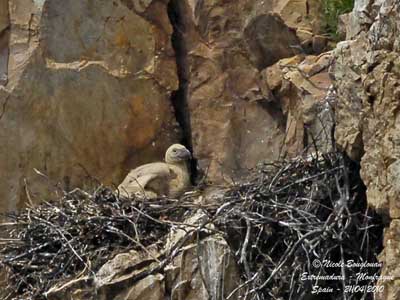
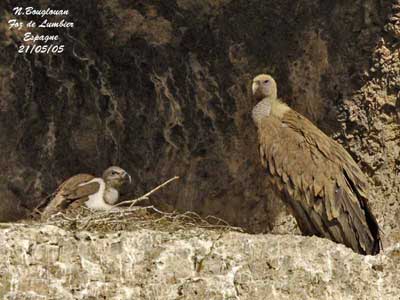
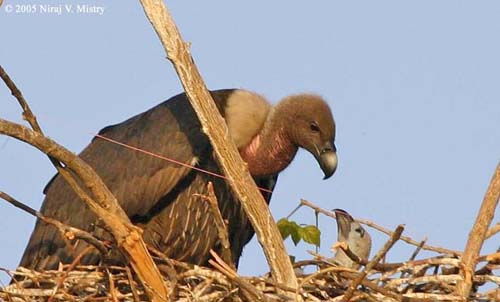
The nesting period varies from 70-85 to 120-135 days. The young depend on parents during several months, 4 to 12, often until the next breeding season.
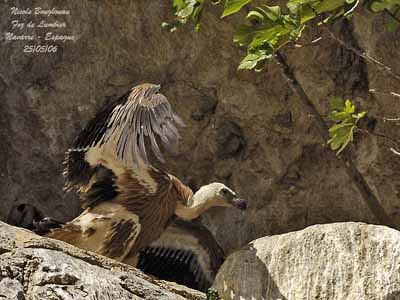
Vultures are often seen soaring on spread wings at great height, using the thermal currents close to the cliffs to rise in the air. They can soar during long periods and rarely flaps their wings except to take off.
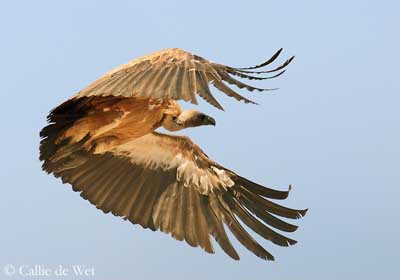
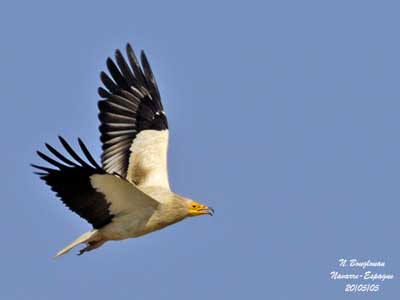
Some species such as the Himalayan Vulture and the Rüppell’s Vulture are able to fly very high, and to manage the low air pressure and the cold temperature at such high elevation.
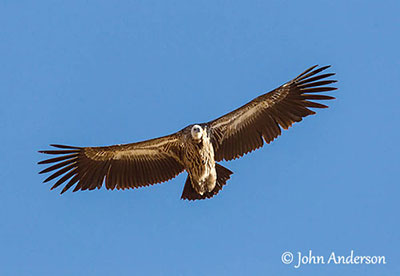

The most part of the species are sedentary, others are partially migratory or vagrants, often moving according to the food sources and the weather conditions, or performing altitudinal movements.
The young birds often move after the nesting season, as well dispersing over long distances, as following caravans and domestic herds.
The Egyptian Vulture from the northern parts of the range migrates, crossing to Africa at Gibraltar.
In Eurasian Griffon Vulture, the young birds disperse widely, and can be seasonally nomadic, according to the climate and the movements of the livestock.
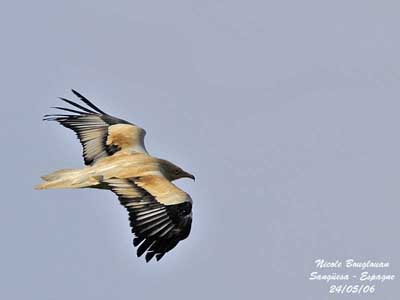
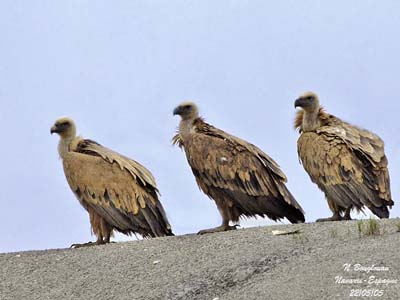
Eurasian Griffon Vulture - Gyps fulvus
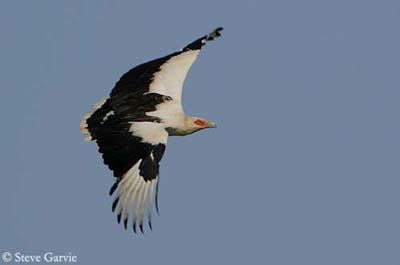
Gypohierax angolensis
The Old World vultures are present in sub-Saharan Africa, Israel and Arabian Peninsula, southern Europe, Central Asia and India, and Malay Peninsula.
They frequent various types of habitats, from open country and savannahs or steppes, to mountainous areas with cliffs, sometimes at high elevation. Some of them favours the areas near water such as the Palm-nut Vulture, others prefers more arid regions such as the Egyptian Vulture. In India, the White-rumped Vulture, the Long-billed Vulture and the Red-headed Vulture can be seen near villages, towns and cities where they gather at rubbish-dumps.
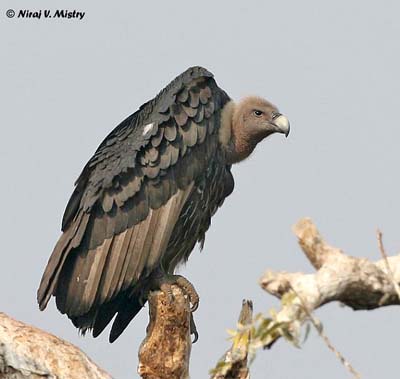
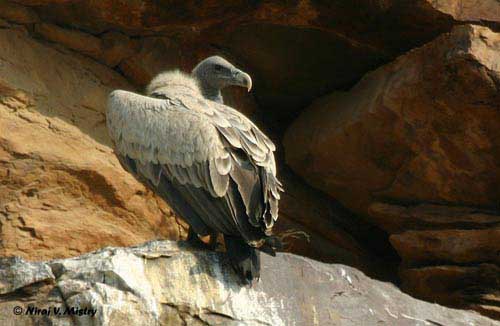
The vultures have been and still are persecuted throughout their range, for various reasons. They are accused to kill livestock, and mainly in France and Spain.
Maybe they can attack a disabled or weak animal, or a new-born lamb, attracted by the blood of the placenta at the moment of the birth, but they are not able to kill healthy animals because they do not have the tools for that, as previously told.
The vultures need to be helped and fed at feed-stations, because they lack carcasses and they are hungry. For this reason, they approach the domestic herds and they are seen closer to villages and towns than formerly.
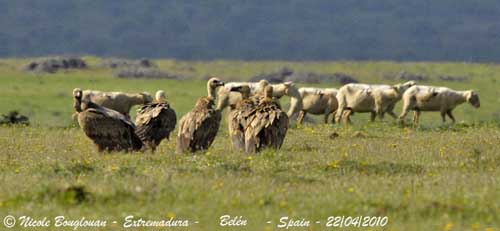
Gyps fulvus
But in India, another problem occurred some years ago, with the dramatic decrease of the populations of Long-billed Vulture, Slender-billed Vulture (Gyps tenuirostris) and White-rumped Vulture.
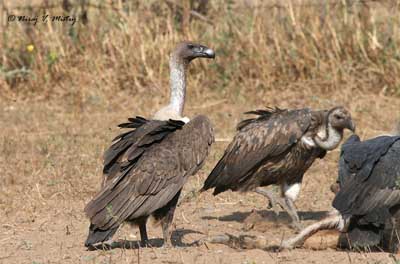
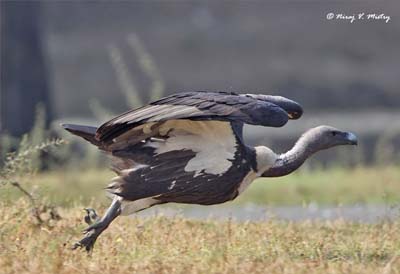
The raptors were fed with remains of meat and bones given by humans in a large area where some hundreds or thousands of vultures were gathered. But several years ago, the death of large numbers of these raptors involved huge declines.
These raptors were eating the flesh of livestock treated with a veterinary drug named Diclofenac. As result, the vultures have been poisoned by this drug, but several years were necessary to find the true reason, and during these years, the drug has continued to kill them.
Today, the Diclofenac is forbidden, but how to be sure that it is really stopped?
Because the vultures were useful to eat the corpses of the dead in some Indian communities, they were protected by the population, and regularly fed. But now, the lack of these scavengers is sorely felt.
The Slender-billed Vulture (Gyps tenuirostris), the Long-billed Vulture or Indian Vulture (Gyps indicus), the White-rumped Vulture (Gyps bengalensis) and the Red-headed Vulture (Sarcogyps calvus) are today Critically Endangered.
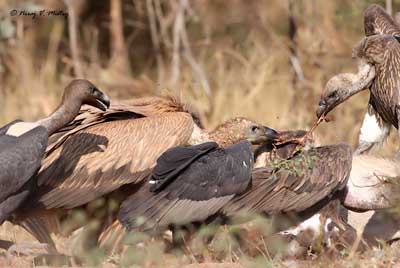
Gyps bengalensis
In Africa, the White-headed Vulture (Trigonoceps occipitalis), the Cape Vulture (Gyps coprotheres) and the Lappet-faced Vulture (Torgos tracheliotus) are classified as Vulnerable. They are threatened by the lack of food due to the changes in farm practices involving less livestock mortalities, poisoned and persecuted and their habitat is destroyed.
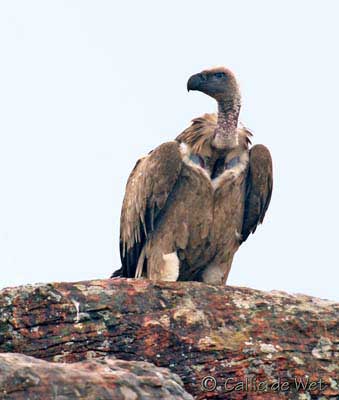
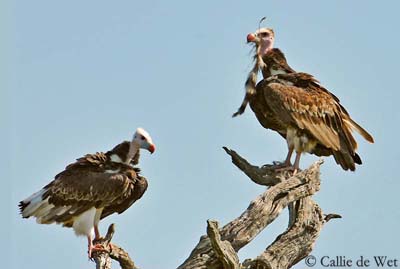
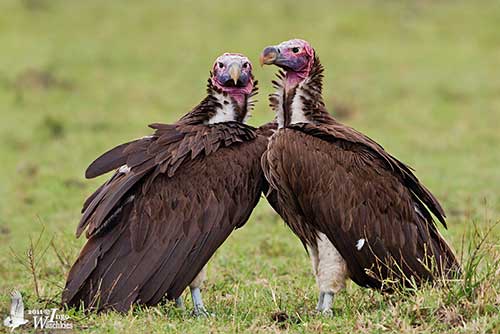
Torgos tracheliotus
The Egyptian Vulture (Neophron percnopterus) is evaluated as Endangered for the same reasons.
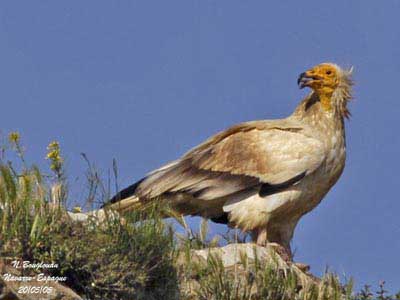
Neophron percnopterus
The White-backed Vulture (Gyps africanus), the Rüppell’s Vulture (Gyps rueppellii) and the Eurasian Black Vulture (Aegypius monachus) are classified as Near Threatened. These species suffer disturbances at nest, habitat loss, illegal poisoning, persecutions and lack of food.
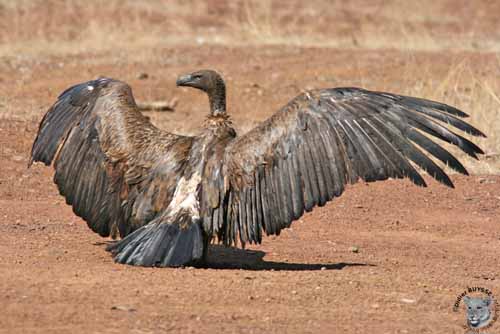
Gyps africanus
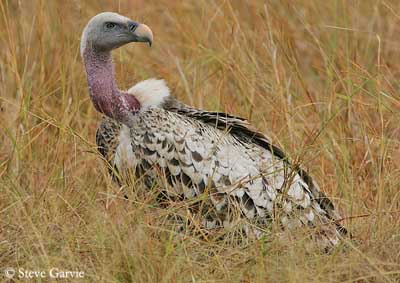
And finally, the Hooded Vulture (Necrosyrtes monachus), the Himalayan Vulture (Gyps himalayensis), the Eurasian Griffon Vulture (Gyps fulvus), the Bearded Vulture (Gypaetus barbatus) and the Palm-nut Vulture (Gypohierax angolensis) are evaluated as Least Concern, in spite of the same threats that in other species but on a much smaller scale.
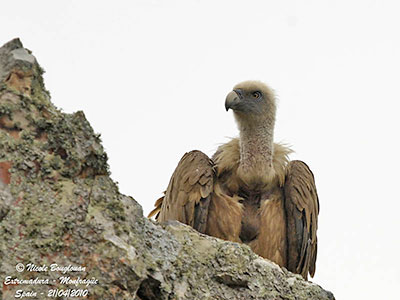
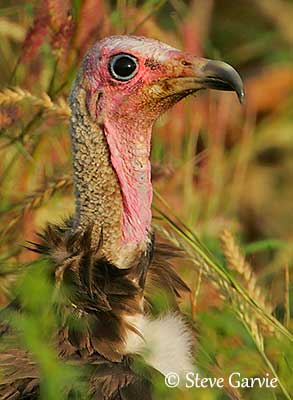
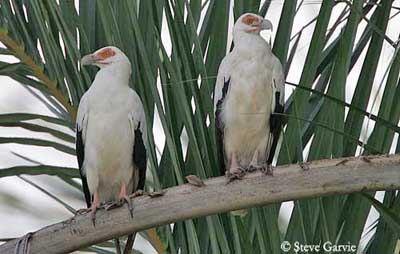
Necrosyrtes monachus
Palm-nut Vulture - Gypohierax angolensis
Eurasian Griffon Vulture - Gyps fulvus
Protection and conservation projects of the habitat and the raptors are active or in progress. The aerial power lines are in decrease, avoiding collisions while flying.
Reserves have been created throughout the most part of the range for the protection of the vultures, and take part in the human education.
But numerous problems are far short for being solved, and some species are close to extinction.
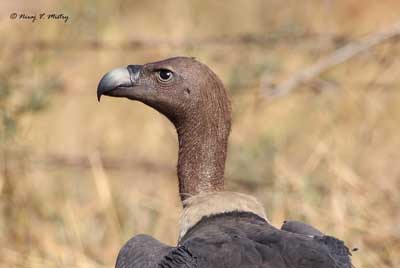
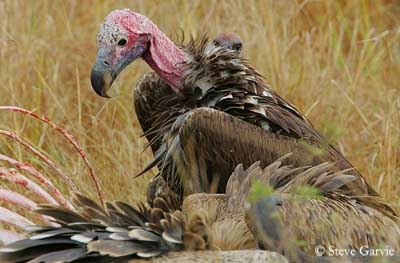
White-rumped Vulture - Gyps bengalensis
Lappet-faced Vulture - Torgos tracheliotus
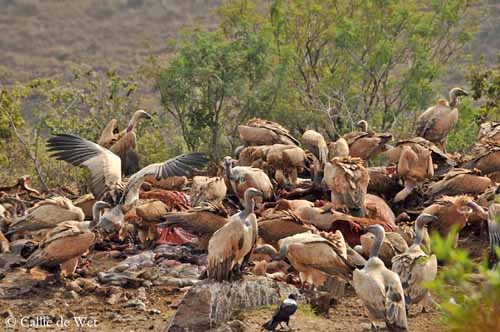
Gyps coprotheres
Nevertheless, that is so nice to see these large birds flying in the blue sky, carried away by the thermals along the cliffs which shelter their life or over the wild landscapes providing them something to feed.
They are so important for the nature. We cannot continue to kill them because we need them!
